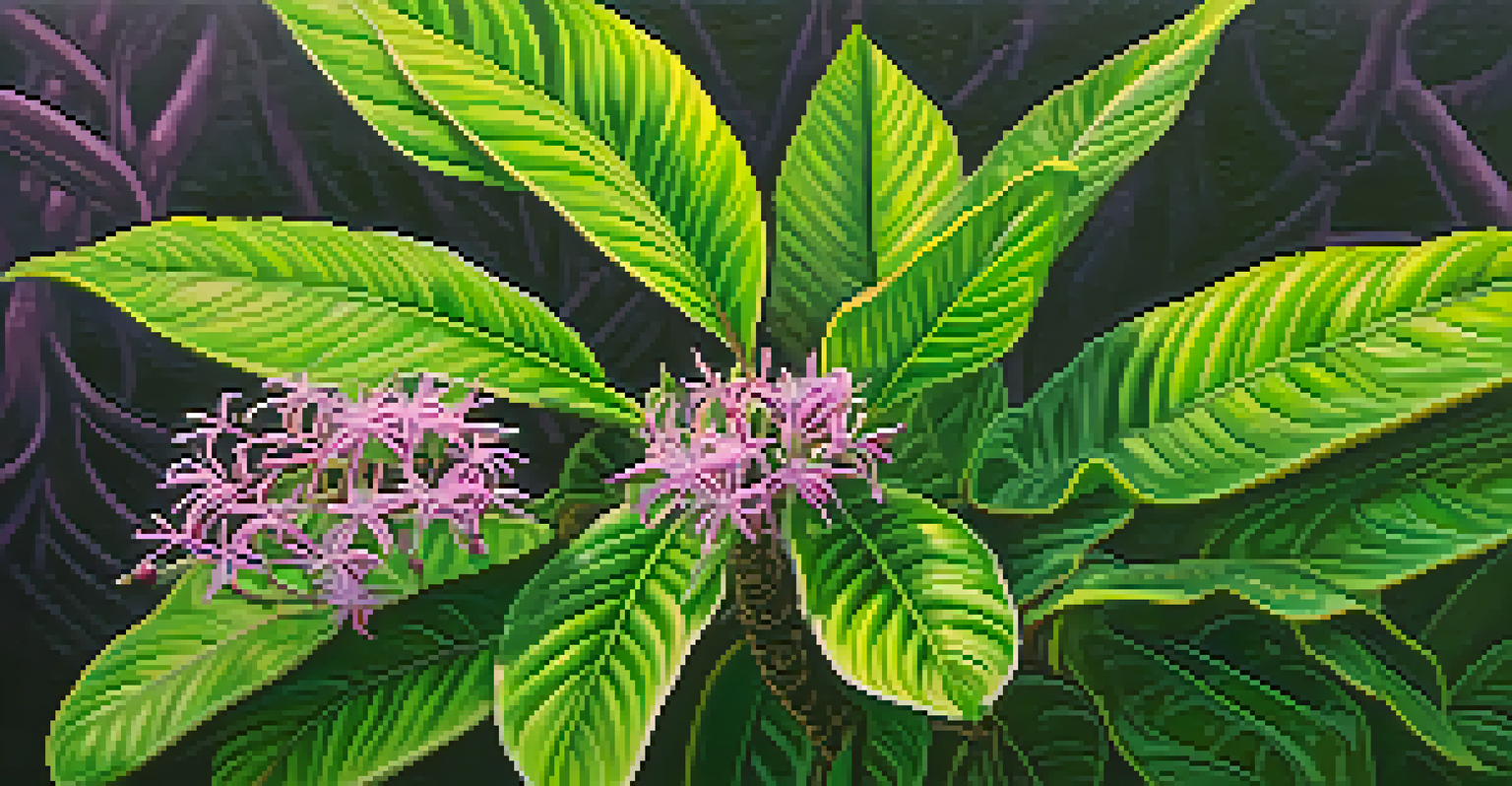The Healing Power of Nature: Entheogens and Ecology

Understanding Entheogens and Their Role in Healing
Entheogens are substances that can induce altered states of consciousness, often used in spiritual or therapeutic settings. These natural compounds, derived from plants and fungi, have been employed for centuries across various cultures to promote healing and self-discovery. The term 'entheogen' itself means 'generating the divine within,' which highlights their potential to connect users with deeper aspects of themselves and the world around them.
Nature does not hurry, yet everything is accomplished.
Recent studies have unveiled the therapeutic benefits of entheogens in treating mental health conditions such as depression and PTSD. For instance, substances like psilocybin from mushrooms and ayahuasca have shown promising results in clinical trials, providing relief and transformative experiences for many individuals. This surge in interest reflects a growing recognition of how these substances can facilitate profound healing journeys.
However, the use of entheogens must be approached with care and respect. It's essential to consider the context in which they are used, ensuring that individuals have proper guidance and support during their experiences. This responsible approach promotes not only personal healing but also a deeper appreciation for the natural world from which these substances originate.
The Interconnection Between Nature and Healing
Nature has an innate ability to heal, offering countless benefits for our mental and physical well-being. Spending time outdoors, surrounded by greenery and wildlife, can reduce stress, improve mood, and enhance overall health. This connection to nature is often referred to as 'biophilia,' a term coined by psychologist Eric Fromm, suggesting that humans have an inherent affinity for the natural world.

Research supports the idea that immersion in nature can bolster our immune systems and lower cortisol levels, which is a hormone associated with stress. Simple activities like walking in a park or gardening can foster feelings of tranquility and connection, reinforcing the idea that nature itself is a powerful ally in our healing process. This is especially potent when combined with the use of entheogens, which can heighten our awareness of nature’s beauty and complexity.
Entheogens Enhance Healing Journeys
Entheogens, such as psilocybin and ayahuasca, have shown promise in treating mental health issues and fostering profound healing experiences.
Moreover, engaging with nature can encourage mindfulness, a practice that enhances our mental resilience. By being present in natural settings, we learn to appreciate the moment and cultivate gratitude—two essential components of emotional well-being. This symbiotic relationship between nature and our mental health emphasizes the importance of protecting our environments for the sake of our own healing.
Cultural Perspectives on Entheogens and Nature
Throughout history, various cultures have recognized the healing potential of entheogens, often integrating them into their spiritual practices. Indigenous communities have used these natural substances for centuries, viewing them as sacred tools for connecting with the divine and promoting communal well-being. This cultural wisdom highlights the importance of understanding the historical and ecological context of these plants before engaging with them.
The greatest wealth is to live content with little.
For example, the use of peyote in Native American ceremonies serves not only as a spiritual guide but also as a means to foster community and healing. These traditions remind us that the relationship between humans and nature is deeply rooted in respect and reciprocity. As we explore the modern applications of entheogens, we must honor these traditions and the knowledge they provide regarding sustainable practices and the ethical use of natural resources.
Incorporating these cultural perspectives into our understanding of entheogens can enhance our appreciation for nature's role in healing. It encourages us to adopt a holistic view that encompasses not just individual healing, but also the health of our ecosystems. By recognizing the interconnectedness of all life, we can foster a greater sense of responsibility towards both our personal well-being and the environment.
Ecology's Role in Promoting Healing
Ecology, the study of interactions between living organisms and their environment, plays a crucial role in understanding how healing can be achieved through nature. Healthy ecosystems provide the resources needed for both physical and mental wellness, from clean air and water to diverse plant life that can yield medicinal properties. By nurturing our ecological environments, we also nurture our own health.
The degradation of natural habitats, driven by human activity, threatens not only biodiversity but also our own well-being. As we lose these vital ecosystems, we also lose the healing benefits they offer. This creates a compelling argument for environmental conservation, showcasing how protecting nature directly correlates with promoting human health and healing.
Nature's Role in Well-Being
Engaging with nature can significantly reduce stress and improve mental health, highlighting our intrinsic connection to the natural world.
Engaging in ecological practices, such as planting trees or participating in community clean-up efforts, can also foster a sense of purpose and connection. These activities not only benefit the environment but also enhance mental health through the fulfillment of contributing to a greater cause. Thus, ecology and healing go hand in hand, highlighting the importance of a balanced approach to both our planet and our well-being.
Modern Science Meets Ancient Wisdom
The resurgence of interest in entheogens has sparked a fascinating intersection between modern science and ancient wisdom. Researchers are increasingly looking to traditional practices to inform contemporary therapeutic approaches, recognizing that many ancient cultures have long understood the benefits of these substances for healing. This blending of knowledge provides a rich tapestry from which we can draw insights into effective healing practices.
Scientific studies are beginning to validate the claims made by indigenous practitioners, showcasing the potential for entheogens to reshape our understanding of mental health treatment. For instance, the use of MDMA in therapy for PTSD has shown remarkable results, bridging the gap between ancient methods and modern clinical applications. This convergence not only enhances our therapeutic toolkit but also emphasizes the importance of respecting and learning from traditional practices.
Moreover, as we explore these ancient practices through a scientific lens, we gain a deeper appreciation for the intricacies of human consciousness. This understanding can inspire a more holistic view of healing—one that considers not just the mind and body but also the spirit and our connection to the natural world. Ultimately, this synthesis of ancient wisdom and modern science can pave the way for innovative healing practices that honor both tradition and progress.
The Therapeutic Landscape of Nature
The therapeutic landscape, a term that refers to places where healing occurs, is often found within nature. Whether it's a tranquil forest, a serene beach, or a majestic mountain, these natural settings offer unique opportunities for recovery and rejuvenation. The beauty and tranquility of these environments can have profound effects on our mental and physical health, providing a perfect backdrop for healing practices that may include entheogens.
Nature's therapeutic landscapes can be enhanced through intentional design, such as creating gardens or outdoor spaces specifically for healing. These environments encourage individuals to engage with nature, facilitating mindfulness and relaxation. Research has shown that spending time in such spaces can lower stress levels and promote feelings of well-being, making them invaluable resources for those seeking healing.
Integrating Ancient Wisdom with Science
The combination of traditional practices and modern scientific research offers valuable insights into effective healing methods involving entheogens.
Furthermore, integrating entheogenic experiences into these landscapes can amplify their healing potential. The combination of nature’s calming presence with the introspective qualities of entheogens can lead to transformative experiences that foster personal growth and ecological awareness. This approach not only aids individual healing but also cultivates a deeper connection to the natural world, reinforcing the idea that healing occurs on multiple levels.
Embracing a Holistic Approach to Healing
Embracing a holistic approach to healing means recognizing the interconnectedness of mind, body, spirit, and nature. This perspective encourages us to look beyond traditional medical models and consider how our environment influences our well-being. By incorporating entheogens and ecological practices into our healing journeys, we can create a more balanced and comprehensive approach to health.
This holistic view also emphasizes the importance of community and connection. Healing is often not a solitary journey but one that benefits from support and shared experiences. Engaging with others in nature, whether through group therapy sessions or community events, can enhance the healing process and promote a sense of belonging and support.

Ultimately, as we navigate the complexities of modern life, incorporating the healing power of nature and entheogens can lead to profound transformations. By honoring the wisdom of the past and the insights of contemporary science, we can cultivate a more sustainable and nurturing approach to our health and the environment. This journey toward holistic healing invites us to reconnect with ourselves, each other, and the world around us.